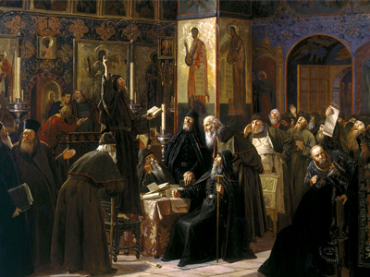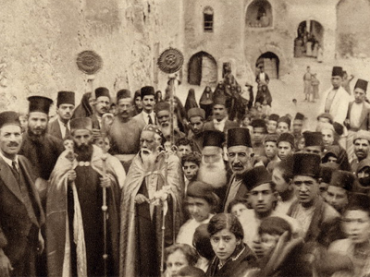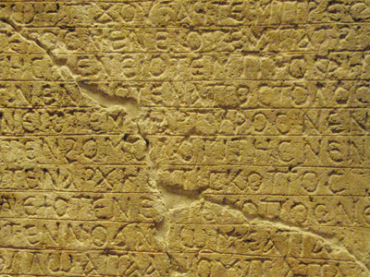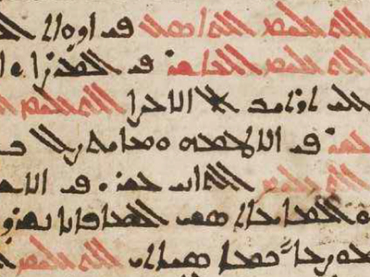Syriac and Eastern Christianity
Inscriptions sémitiques de la Syrie, de la Mésopotamie et de la région de Mossoul
Edited and Translated by Henri Pognon
Series: Syriac Studies Library 166
ISBN: 978-1-61719-418-4
This impressive volume is a collection of inscriptions, mostly Syriac, but also two in Akkadian and some in Aramaic, collected by Pognon during travels in the Middle East. They are accompanied with detailed notes and French translations.
$185.00
Der Ketzer-Katalog des Bischofs Maruta von Maipherkat
Translation and Introduction by Adolf Harnack
Series: Analecta Gorgiana 601
ISBN: 978-1-61719-432-0
This short catalogue lists the heresies known on the Syrian frontier of the Roman Empire in the beginning of the fifth century.
$34.00
Der Benanbrief
Eine moderne Leben-Jesu-Fälschung des Herrn Ernst Edler von der Planitz
By Carl Schmidt; In Collaboration With Hermann Grapow
Series: Analecta Gorgiana 605
ISBN: 978-1-61719-436-8
This work reveals the uncovering of a forged letter about Jesus by the Berlin Professor of Theology with a consideration of the career and historical sense of the forger.
$54.00
The Syrian Voice
al-ṣawt al-suryānī
Series: Abrohom Nuro Library 6
ISBN: 978-1-61719-451-1
This book speaks of the internal struggle that arose within the Syrian Orthodox Church in the twentieth century.
$52.00
A Brief Study on the Origins of Arabic and Syriac Phrases in Italian, Spanish, French, English, Gree
نبذة في أصول الألفاظ السامية... التي دخلت في اللغات الإيطالية والإسبانية... وبالعكس
Series: Abrohom Nuro Library 7
ISBN: 978-1-61719-452-8
This book outlines the connections between the Arabic and European languages, giving a brief listing of European words and phrases with their Arabic equivalent.
$54.00
The Crusades in Syrian Monuments
al-ḥurūb al-ṣalībiyya fī al-āthār al-suryāniyya
Series: Abrohom Nuro Library 8
ISBN: 978-1-61719-453-5
An account of the Crusades from the Syrian perspective as detailed by the priest Isaac Armala. A non-Western account of the epic battle perfect for students of history.
$92.00
Grammar of the Syriac Language
al-lugha al-suryāniyya
Series: Abrohom Nuro Library 9
ISBN: 978-1-61719-454-2
This is a thorough academic tutorial of the Syriac language beginning with its history and ending with the learning of the language itself.
$145.00
Patriarchs of the Syrian Orthodox Church in the Nineteenth Century
baṭārikat al-suryān fī āl-qarn āl-tāsi` `ashr
Series: Abrohom Nuro Library 11
ISBN: 978-1-61719-456-6
A history of the Syrian Orthodox Patriarchs of the nineteenth century as they struggle against political, internal, and external opposition.
$112.00
The Theological School of Antioch 290-430 A.D.
madrasat ānṭākya al-lāhūtiyya
Series: Abrohom Nuro Library 12
ISBN: 978-1-61719-457-3
An essay expounding the historical rise and decline of the Theological School of Antioch.
$103.00
Treatise on the Principals of Translation Techniques from Arabic into Syriac
risāla fī ’uṣūl al-ta`rīb `an al-suryāniyya
By Aphram I Barsoum; Preface by George Saleeba
Series: Abrohom Nuro Library 13
ISBN: 978-1-61719-458-0
Author Ephraam Barsom deliberates on the logistics of translation versus transliteration of Syriac into Arabic. This is a great read for anyone interested in the translation of Syriac into Arabic.
$115.00
Aramaic Languages and their Study
āl-lugha āl-ārāmiyya wa-ādābuhā
Series: Abrohom Nuro Library 14
ISBN: 978-1-61719-459-7
An Overview of the compilation and history of the Aramaic Language from various dialects.
$109.00
Practical Guide to Conversational Syriac
dalīl al-takallum fī al-lugha al-suryāniyya
Series: Abrohom Nuro Library 15
ISBN: 978-1-61719-460-3
This is a beginner’s guide to conversational Syriac with translations in French and Arabic.
$46.00
The Influences of Syriac on the Lebanese and Syrian Dialects
al-dawāthir al-suryāniyya fī lubnān wa-sūriyya
Series: Abrohom Nuro Library 16
ISBN: 978-1-61719-461-0
This book presents a look at the effects of the Aramaic language as it appears in Lebanon and Syria.
$61.00
Non-Native Borrowings into the Lebanese Syrian Dialect
gharā'ib al-lahja al-lubnāniyya al-sūriyya
Series: Abrohom Nuro Library 18
ISBN: 978-1-61719-463-4
In comparing the formal Arabic language with colloquial Lebanese Syrian Arabic, Raphael Nakhla Al-Yasou`y finds a large list of foreign words that have unknowingly worked their way into the local dialect.
$81.00
Spot Light on the Decision to Grant Cultural Rights to Syriac Speaking Citizens of Iraq
'aḍwā' `alā qarār manḥ al-ḥuqūq al-thaqāfiyya lil-muwāṭinīn al-nāṭiqīn bil-suryāniyya
Compiled by Jamil Raphael & Abd- al- Ahad Benyameen
Series: Abrohom Nuro Library 19
ISBN: 978-1-61719-464-1
This is a book filled with documents, details and glimpses of Syria after its government granted cultural rights to its Syriac speaking citizens.
$120.00
A Brief History on its Origins, Principals, and its Most Prominent Teachers
madrasat nuṣaybīn al-shahīra: nabdha tārīkhiyya fī ’aṣlihā wa-qawānīnihā wa-fī al-`ulamā’ al-ladhīna qāmū fīhā
By Addai Scher
Series: Abrohom Nuro Library 20
ISBN: 978-1-61719-465-8
This is a brief history of the life of the School of Nisibis, its teachings, traditions, and influence.
$46.00
Tangible Proofs of the Exchange between Syriac and Arabic
al-barāhīn al-ḥisiyya `alā taqāruḍ al-suryāniyya wal-`arabiyya
Series: Abrohom Nuro Library 22
ISBN: 978-1-61719-469-6
In this linguistics book, Ignatius Yacoub III documents the relationship between the Syriac and Arabic languages; postulating that both are intrinsic to the study of the other.
$155.00
Acta Sanctorum Confessorum Guriae et Shamonae Exarata Syriaca Lingua a Theophilo Edesseno
The Acts of Guria and Shmona in Syriac, with Latin Translation
Edited and Translated by Ignatius Ephraem II Rahmani
Series: Analecta Gorgiana 666
ISBN: 978-1-61719-616-4
Rahmani here presents the first edition of the martyrdom stories of Guria and Shmona in Syriac, who were killed during the Diocletian persecution. The editor also gives a Latin translation and discusses historical and textual matters in the introduction.
$49.00
Codicum Syriacorum Specimina ad Illustrandam Dogmatis de Coena Sacra nec non Scripturae Syriacae His
Specimens of Syriac Manuscripts
Series: Analecta Gorgiana 667
ISBN: 978-1-61719-617-1
This unique volume has a discussion of the lives of the Fathers extant in Syriac texts then at the British Museum. Plates reproduce a number of fragments of these manuscripts, together with Dietrich’s descriptions.
$40.00
Note sur l'ouvrage syriaque intitulé Le Jardin des Délices
By J.-B. Chabot
Series: Analecta Gorgiana 669
ISBN: 978-1-61719-619-5
In this short work, originally published in the Festschrift for Nöldeke, Chabot gives a notice and overview of the Gannat Bussame, a commentary on the East Syriac lectionary and an important witness to the East Syriac exegetical tradition.
$35.00
Syriac Noun and Verb Paradigms in the Eastern Pronunciation (Chaldean)
By Anonymous
Series: Analecta Gorgiana 670
ISBN: 978-1-61719-620-1
This handbook for grammatical forms in Syriac provides students and scholars with a quick reference for the various forms of nouns, pronouns, and verbs, and also offers a simple way to learn Syriac grammatical terminology.
$51.00
Reading Book for Urmia Aramaic
By Anonymous
Series: Analecta Gorgiana 671
ISBN: 978-1-61719-621-8
This reading or practice book for this Aramaic dialect was originally published at the Catholic Press of Urmia. It progresses from simple letter forms on to words, phrases, sentences, and then short narratives.
$45.00
Catholic Catechism in Urmia Aramaic
By Anonymous
Series: Analecta Gorgiana 672
ISBN: 978-1-61719-622-5
This catechism in the Aramaic dialect of Urmia, originally published at the Lazarist Press there, provides questions and answers regarding the Catholic faith in that language.
$52.00
Catholic Catechism in the Mosul Dialect of Aramaic (Sureth)
Petit catéchisme en langue chaldéenne vulgaire
By Anonymous
Series: Analecta Gorgiana 673
ISBN: 978-1-61719-623-2
This is the second printing of a Catholic catechism in the Aramaic dialect of Mosul, originally published at the Dominican Press there.
$40.00
Initial Syriac Reading Book
Syllabaire chaldéen
By Anonymous
Series: Analecta Gorgiana 674
ISBN: 978-1-61719-624-9
This small practice book for learning to read Syriac went through several printings at the Dominican Press in Mosul. It guides the reader through letter forms into words and then some practice reading passages.
$42.00
Filter by
Filter by price
Filter by manufacturer































